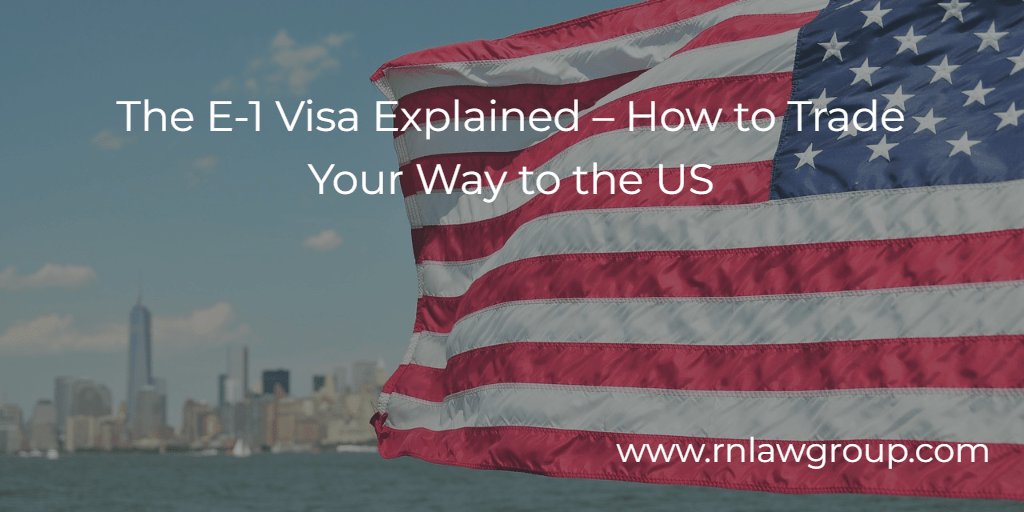
The E-1 Visa Explained – How to Trade Your Way to the US
Introduction
The E-1 visa, commonly referred to as the Treaty Trader visa, is a non-immigrant visa for nationals of countries that have a commerce and navigation treaty with the United States. This visa is designed to facilitate international trade between the U.S. and the treaty country by allowing its nationals to enter the U.S. to engage in substantial trade. The E-1 visa is an excellent opportunity for business owners, managers, and employees involved in trade activities to expand their business operations into the U.S. market.
Eligibility Criteria
To qualify for the E-1 visa, several specific requirements must be met:
- Nationality: The applicant must be a national of a country with which the U.S. maintains a treaty of commerce and navigation. A list of these treaty countries can be found on the U.S. Department of State’s website.
- Trade: The trade must be substantial. This means that there should be a significant and continuous flow of goods, services, or technology between the U.S. and the treaty country. The trade must constitute more than 50% of the total international trade conducted by the applicant’s business.
- Principal Trade: The trade must be principally between the U.S. and the treaty country. Over 50% of the total volume of international trade must be between these two countries.
- Executive or Supervisory Role: The applicant must be employed in a supervisory or executive capacity or possess specialized skills that are essential to the efficient operation of the business.
- Intention to Depart: The applicant must demonstrate an intent to depart the U.S. upon the termination of their E-1 status.
Application Process
The process for obtaining an E-1 visa involves several steps:
- Form DS-160: The applicant must complete and submit the online non-immigrant visa application form DS-160.
- Treaty Trader Visa Application: This involves preparing documentation that proves the existence of substantial trade between the U.S. and the treaty country. Key documents include financial statements, trade invoices, shipping receipts, and other records that verify the trade activities.
- Interview at U.S. Embassy/Consulate: The applicant must schedule and attend an interview at a U.S. Embassy or Consulate in their home country. During the interview, the applicant will need to provide evidence supporting their eligibility for the E-1 visa.
- Supporting Documents: The applicant must present various supporting documents during the interview, such as a valid passport, proof of substantial trade, proof of nationality, evidence of the applicant’s role in the business, and proof of intent to return to the treaty country after the visa expires.
Duration of Stay
Initially, the E-1 I-94 is granted for a period of up to two years. However, the visa validity depends on the treaty county and can be renewed indefinitely, provided that the applicant continues to meet the visa requirements and the trade between the U.S. and the treaty country remains substantial. Each time the visa holder enters the U.S., they are generally granted a two-year period of stay.
Advantages of the E-1 Visa
- Flexibility: The E-1 visa offers considerable flexibility for traders and their families. Spouses and unmarried children under 21 can accompany the principal visa holder to the U.S. and are eligible for E-1 dependent visas. Spouses can also apply for work authorization, allowing them to work in the U.S.
- Indefinite Renewals: Unlike many other non-immigrant visas, the E-1 visa can be renewed indefinitely, provided the trade activities continue to meet the necessary criteria. This feature makes it an attractive option for long-term business operations in the U.S.
- No Quota Limitations: The E-1 visa is not subject to annual quota limitations, making it accessible year-round for eligible applicants.
Challenges and Considerations
- Substantial Trade Requirement: One of the primary challenges of the E-1 visa is meeting the substantial trade requirement. Applicants must demonstrate a significant and continuous flow of trade, which can be a high bar for smaller businesses or startups.
- Proof of Intent to Depart: Although the E-1 visa allows for indefinite renewals, visa holders must consistently demonstrate their intent to depart the U.S. after their authorized stay ends. This requirement can sometimes complicate the renewal process.
- Country Eligibility: The E-1 visa is only available to nationals of treaty countries. Individuals from non-treaty countries cannot apply for this visa, limiting its accessibility.
Example of a Successful E-1 Visa Case:
Consider the case of an international trading company based in Japan, a treaty country. The company specializes in exporting high-quality electronics to the U.S. market. To expand its operations, the company decides to establish a U.S. office and applies for an E-1 visa for its CEO.
Step-by-Step Process:
- Eligibility Assessment: The company confirms that it qualifies for the E-1 visa based on its substantial trade volume, with over 60% of its international trade conducted with the U.S.
- Documentation Preparation: The company gathers all necessary documents, including trade invoices, shipping records, financial statements, and proof of the CEO’s nationality and executive role.
- DS-160 Form Submission: The CEO completes and submits the DS-160 form and pays the visa application fee.
- Interview Preparation: The CEO schedules an interview at the U.S. Embassy in Tokyo and prepares for the interview by organizing all supporting documents.
- Visa Interview: During the interview, the CEO presents the documentation and answers questions about the company’s trade activities, the substantial trade volume, and the intention to return to Japan after the authorized stay.
- Visa Approval: The U.S. Embassy approves the E-1 visa, allowing the CEO to establish and oversee the company’s U.S. operations.
Conclusion
The E-1 visa is a valuable tool for facilitating international trade and fostering business growth between the U.S. and treaty countries. By understanding the eligibility criteria, application process, and advantages and challenges associated with the E-1 visa, businesses and individuals can effectively navigate the complexities of this visa category. For those engaged in substantial trade, the E-1 visa offers a unique opportunity to expand their reach and capitalize on the dynamic U.S. market.
By: Felipe Jimenez
Felipe Jimenez is an Associate Attorney at Reddy & Neumann, P.C. He works in the Non-Immigrant Visa (NIV) Department where he assists clients through all phases of the non-immigrant visa process.
Reddy & Neumann, P.C. has been serving the business community for over 20 years and is Houston’s largest immigration law firm focused solely on US. Employment-based immigration. We work with both employers and their employees, helping them navigate the immigration process quickly and cost-effectively.

